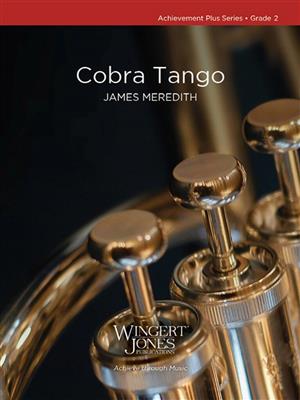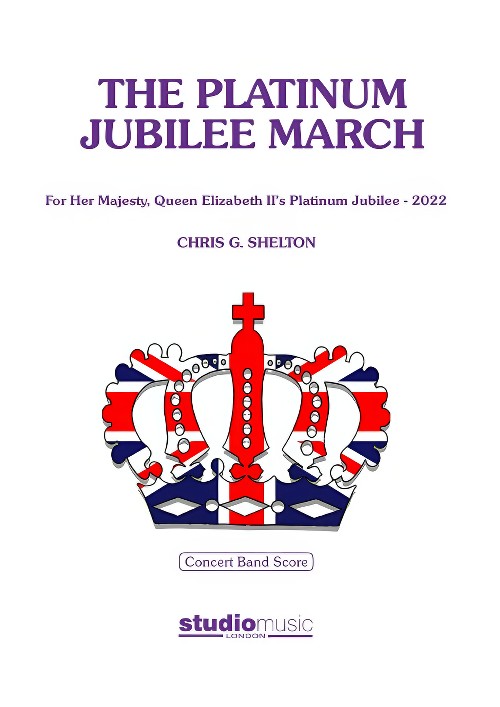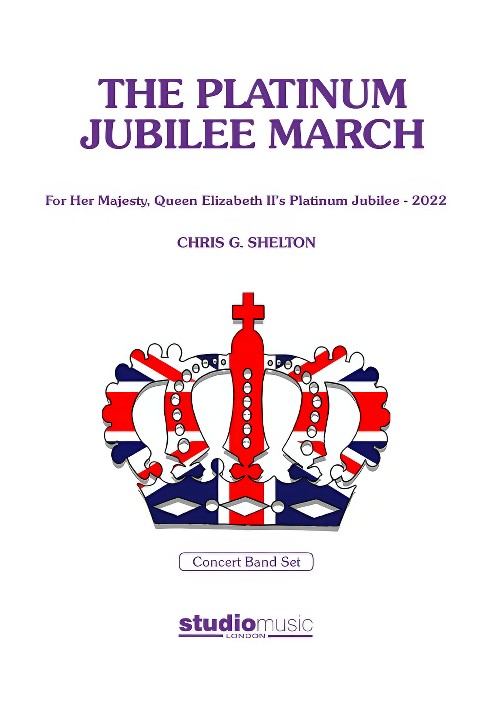Results
-
 £71.50
£71.50Cobra Tango - James Meredith
James Meredith slithers around this new work with twirling chromatic lines that are sure to keep players on their toes! Imagine the hiss of a cobra in a trance as it dances around the room in this clever and accessible work for the young band. Audiences will love this one, and a few might just start to dance too!
Estimated dispatch 7-14 working days
-
 £86.00
£86.00Postcard From Machu Picchu - Dirk Brossé
Sir Dirk Bross, music director at the Philadelphia Chamber Orchestra, is a versatile composer of orchestral and symphonic repertoire, chamber music, film & musical. His compositions are performed worldwide by the most prominent orchestras and soloists. About the new series of 10 "Musical Postcards" for wind band, Dirk says the following: "Composing is a commitment; it is my life's mission. For me composing means creating a vacuum around myself and allowing myself to be submerged by impressions. It is a continual struggle between fantasy and reality, between dream and reality. Out of chaos of sounds and emotions I try to order my thoughts by juggling shreds of melodies, original chords, striking sound colours and alternating rhythms. Melody, harmony, rhythm and sound colours are finally balanced to generate a harmonious universe. This series of ten 'Musical Postcards' are a reflection of my travels, thoughts, discoveries and musical career so far, which has brought me around the globe. I look forward to you joining me on this voyage of discovery..."
Estimated dispatch 7-14 working days
-
 £73.00
£73.00Postcard From Buenos Aires - Dirk Brossé
Sir Dirk Bross, music director at the Philadelphia Chamber Orchestra, is a versatile composer of orchestral and symphonic repertoire, chamber music, film & musical. His compositions are performed worldwide by the most prominent orchestras and soloists. About the new series of 10 "Musical Postcards" for wind band, Dirk says the following: "Composing is a commitment; it is my life's mission. For me composing means creating a vacuum around myself and allowing myself to be submerged by impressions. It is a continual struggle between fantasy and reality, between dream and reality. Out of chaos of sounds and emotions I try to order my thoughts by juggling shreds of melodies, original chords, striking sound colours and alternating rhythms. Melody, harmony, rhythm and sound colours are finally balanced to generate a harmonious universe. This series of ten 'Musical Postcards' are a reflection of my travels, thoughts, discoveries and musical career so far, which has brought me around the globe. I look forward to you joining me on this voyage of discovery..."
Estimated dispatch 7-14 working days
-
 £84.99
£84.99Song of Hope - Johan Nijs
Song of Hope is built up around a main theme with some small motifs woven around it. With this quiet, delicate work, the Belgian composer Johan Nijs has reflected hope of peace in the future. The profound melody reminds us of the fact that a moment's rest is wonderful in the hustle and bustle of our stressful existence. Why not calm down your concert mood with this highly atmospheric work.
Estimated dispatch 7-14 working days
-
 £106.99
£106.99Dance of the Whale - Philip Sparke
Dance of the Whale was commissioned by the Spanish music foundation, Musica et Orbi, at the instigation of its president, Frank De Vuyst. It is part of a unique project which involved nine composers each writing a short movement, describing ananimal of the composers' choice, to form a suite called Bestiarium. A consortium of bands around the world helped to fund the project and the world premiere of the suite took place in March 2013 in Medell n, Colombia. Dance of the Whaleuses the tenor instruments of the band to describe a lazy and graceful dance by a blue whale and is dedicated to endangered species around the world.
Estimated dispatch 7-14 working days
-
 £149.99
£149.99Jericho - Bert Appermont
Jericho is the musical translation of the well-known story from the book of Joshua about the capture of the city of Jericho by the Israelites.Part 1 depicts the cruel journey through the desert to Canaan, the promised land. An emotional lamentation for the yearning for a home, for the end of a roaming existence.The capture of Jericho is the theme of part 2. The city cannot be captured immediately and Jehovah orders an impressive army to march around the city for six days. On the seventh day, they marched around the city seven times and the priests blew their trumpets and the people cried so loud that the walls of Jericho came tumbling down. The Jews stormed the city and drove theinhabitants away. The music clearly reveals the marching army and you can hear the walls falling down with a tremendous noise. However, there is quite some artistic freedom in the actual story.A majestic and grand melody subsequently evokes the triumphant emotions that emerged as the fortified city fell (part 3).Following a personal and romantic interpretation, the scene ultimately ends in a typical Jewish feast (part 4) whereby the virtuosity of melodies played by the woodwinds and the passionate rhythms refer to traditional Jewish music. All themes are repeated in this last part in various forms, often simultaneous and in duelling counterpoint. The piece ends with fragments from the main theme of part 1 in major: peace and quiet return at last.
Estimated dispatch 7-14 working days
-
 £174.99
£174.99The Legend of Flathead Lake - Carl Wittrock
In Scotland, the monster of Loch Ness is a hot issue, but the American state of Montana enjoys a comparable phenomenon going by the name of Montana Nessie. In the western part of this remote state lies Flathead Lake: a lake of 45 kilometres /38miles in lenght and 24 kilometres /15 miles breath. At several places, its depth exeeds 100 metres.Nessies discovery takes us back to the year 1889, when captain James Kerr aboard the passengership U.S.Grant was startled by a ship unknown to himsuddenly approaching his vessel across Flathead Lake. However, it turned out not to be a ship but an undefinable animal of immense size.From that moment onwards, life would never be the same again in and around Flathead Lake.The composer wasinspired by the story, and summarized the events into a symphonic poem, but from a surprising angle:that of the monster. The exiting opening allows us to follow the monster in its natural surroundings.The fast follow-up movement depictsMontana Nessie trotting and frolicking about the Montana woods and prairies.From its abode, it thorougly enjoys everything around it. This period abruptly ends in a short climax (Chimes). The solo for cor anglais marks a new period in themonsters life.The presence of people has a paralizing effect and the apprehensive atmosphere of the slow movement may be felt profoundly.The monster observes and mildly teases the ship. Abhor sounds force the ship to a withdrawal.The movingmusical continuation depicts the triumphant monster dancing an ironic waltz. The monsters fear and anger at the intrusion of his freedom run through the piece like continuous threads, and develop into the works final theme.
Estimated dispatch 7-14 working days
-
 £53.50
£53.50Aztalan (City of Mystery) - Michael Sweeney
The ancient city of Aztalan existed around a thousand years ago in southern Wisconsin, but disappeared mysteriously by around A.D. 1300. Through careful use of tone clusters, haunting melodies and creative percussion effects, thisvery easy work for band portrays a sense of mystery and drama. Dur: 2:45 (Grade 1-1/2)
Estimated dispatch 7-14 working days
-
 £17.95
£17.95The Platinum Jubilee March (Concert Band - Score only) - Shelton, Chris G.
Queen's Birthday Parade, Quick Troop 2022The Platinum Jubilee March was written to celebrate Her Majesty, Queen Elizabeth II's seventy-year reign as monarch of the United Kingdom. Its premiere was televised live around the world as part of the Queen's Birthday Parade which marked the start of the national Platinum Jubilee celebrations.The Queen's Birthday Parade 2022 saw the First Battalion of the Irish Guards trooping their colour. To reflect this, the march begins in a celebratory style and features a melody based around the opening motif of Let Erin Remember - the regimental slow march of the Irish Guards. In traditional style, the march develops excitement both harmonically and melodically, creating a strong sense of drive before reaching a stately trio. This section has a very regal and noble feel, lending subtle harmonic nods to two of the most quintessentially British composers, Gustav Holst, and Sir William Walton. The march culminates in a bold grandioso, featuring florid woodwind lines that are underpinned by a driving trombone and horn countermelody. A forthright restatement of the introductory fanfare brings the march to a very definite and resolved ending.Duration: 3.30
Estimated dispatch 7-14 working days
-
 £87.95
£87.95The Platinum Jubilee March (Concert Band - Score and Parts) - Shelton, Chris G.
Queen's Birthday Parade, Quick Troop 2022The Platinum Jubilee March was written to celebrate Her Majesty, Queen Elizabeth II's seventy-year reign as monarch of the United Kingdom. Its premiere was televised live around the world as part of the Queen's Birthday Parade which marked the start of the national Platinum Jubilee celebrations.The Queen's Birthday Parade 2022 saw the First Battalion of the Irish Guards trooping their colour. To reflect this, the march begins in a celebratory style and features a melody based around the opening motif of Let Erin Remember - the regimental slow march of the Irish Guards. In traditional style, the march develops excitement both harmonically and melodically, creating a strong sense of drive before reaching a stately trio. This section has a very regal and noble feel, lending subtle harmonic nods to two of the most quintessentially British composers, Gustav Holst, and Sir William Walton. The march culminates in a bold grandioso, featuring florid woodwind lines that are underpinned by a driving trombone and horn countermelody. A forthright restatement of the introductory fanfare brings the march to a very definite and resolved ending.Duration: 3.30
Estimated dispatch 7-14 working days
